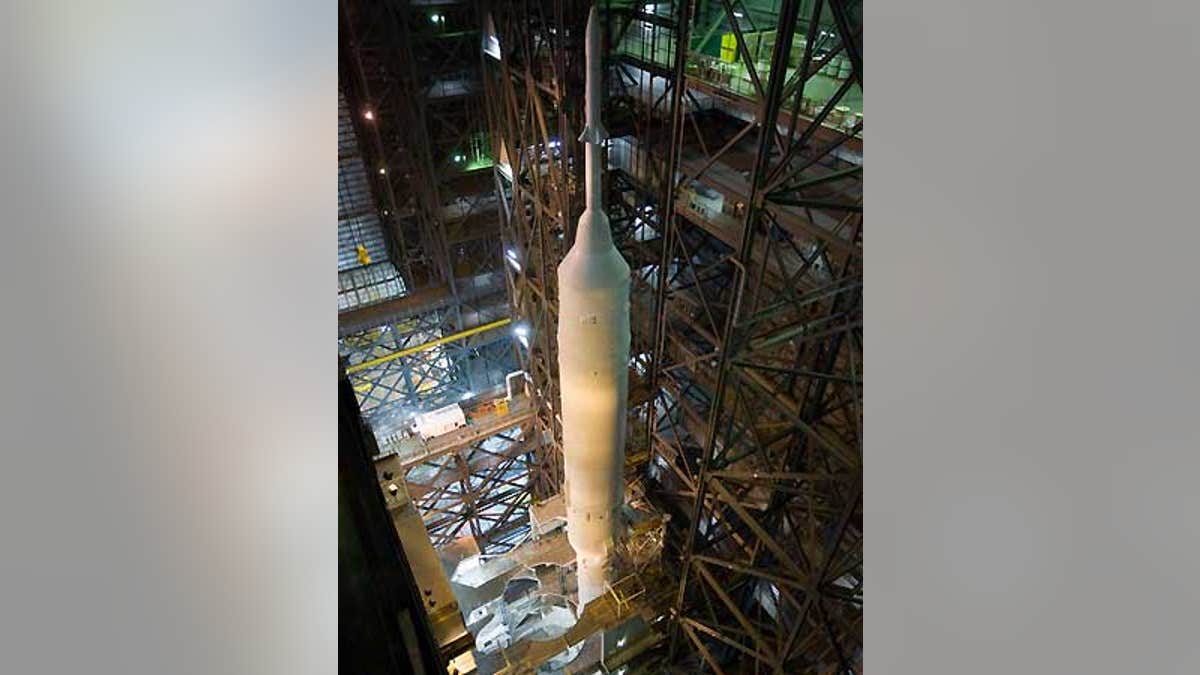
For the first time in more than a quarter-century, a new space vehicle stands ready in NASA Kennedy Space Center (NASA)
NASA's first version of the rocket slated to replace the space shuttle and send astronauts back to the moon will make its debut test launch Oct. 27, four days early, the space agency announced Tuesday.
The rocket, a demonstration booster called Ares I-X, was previously scheduled to blast off Oct. 31, but engineers preparing the booster were able to complete work in time for the earlier liftoff, NASA officials said. Launch is set for 8:00 a.m. EDT (1200 GMT) on Tuesday, Oct. 27 from the Kennedy Space Center in Florida.
"They are doing a launch countdown simulation today," NASA spokesperson Amber Philman told SPACE.com from the spaceport. "That's ongoing as we speak."
Philman said the current launch target must still be finalized by mission managers during a series of review meetings in coming weeks. Engineers padded their work schedule by two full weeks to handle any unexpected glitches while priming Ares I-X for an Oct. 31 flight, but ultimately did not need some of that buffer, which allowed the earlier date, she added.
NASA's new rocket
The Ares I rocket is a two-stage booster designed to launch the Orion spacecraft, which NASA plans to replace its three aging space shuttles once they retire in the next year or two. It stands about 327 feet (100 meters) tall - 14 stories higher than launch-ready shuttles - when fully assembled.
NASA has said that the rocket and its Orion vehicles will not be ready to ferry astronauts to orbit until at least 2015, but a White House-appointed committee that evaluated the agency's exploration plans this summer has said that date could likely slip to 2017.
The committee has submitted a set of five options to overhaul NASA's spaceflight plan for President Barack Obama's review. Some of them do not include the Ares I rocket. NASA's vision of returning astronauts to the moon by 2020 is critically underfunded and would require at least $3 billion a year in extra funding just to meet the lunar goal by the mid-2020s, the committee has said.
Earlier this year, NASA had hoped to launch the Ares I-X flight in July or August, but had to push the test back several times. Not so for the Oct. 27 target, Philman said.
"Everything is looking good with the hardware," Philman said. "They've done the power up of the vehicle and that test went well."
The Ares I's first stage is a giant solid rocket similar to the four-segment boosters used to launch NASA space shuttles, but with an extra fifth segment for more power. The second stage is a liquid-fueled engine that would push Orion capsules to orbit.
NASA conducted the first successful test firing of the Ares I rocket's first stage on Sept. 10.
For the Ares I-X test flight, NASA has built a four-segment first stage capped with a dummy fifth segment, as well as a dummy second stage. The launch is designed to demonstrate the rocket's launch concept, ground processing and stage separation.
The test flight is expected to reach an altitude of about 25 miles (40 km) in about two minutes, with 700 onboard sensors recording its performance. After the first stage separates, the dummy upper stage and Orion simulator will crash into the Atlantic Ocean.
NASA plans to roll the Ares I-X rocket out to Launch Pad 39B at the Kennedy Space Center on Oct. 19. The pad has been refitted to host the Ares I-X rocket with the finishing touches to be completed by next week.
"They should be ready at the pad by the end of the month," Philman said
